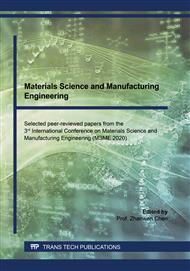[1]
W. Wang, B. Jiang, H. Sun, et al, Prevalence, incidence, and mortality of stroke in China: results from a nationwide population Based survey of adults, Circulation. 8 (2017) 759-771.
DOI: 10.1161/circulationaha.116.025250
Google Scholar
[2]
T. Jin, X.X. Xiong, Diagnosis and treatment of nanoparticles and stroke, Stroke and Nervous Disease. 25 (2018) 597-600.
Google Scholar
[3]
T. Feczkó, J. Tóth, J. Gyenis, Comparison of the preparation of PLGA-BSA nano-and microparticles by PVA, poloxamer and PVP Colloids and Surfaces A, Physicochemical and Engineering Aspects. 7 (2007) 1-8.
DOI: 10.1016/j.colsurfa.2007.07.011
Google Scholar
[4]
M. X. Li. Preparation and application of polylactic acid-glycolic acid copolymer, Heilongjiang Medicine Journal. 25 (2012) 410-412.
Google Scholar
[5]
G.C. Jickling, F.R. Sharp. Blood biomarkers of ischemic stroke, Neurotherapeutics. 8 (2011) 349-360.
DOI: 10.1007/s13311-011-0050-4
Google Scholar
[6]
K. Y. Lin, G. A. Kwong, A. D. Warren, et al.Nanoparticles that sense thrombin activity as synthetic urinary biomarkers of thrombosis, ACS Nano. 7 (2013) 9001-9009.
DOI: 10.1021/nn403550c
Google Scholar
[7]
Z. Zhou, J. Lu, W. W. Liu, et al. Advances in stroke pharmacolog, Pharmacol Ther. 191 (2018) 23-42.
Google Scholar
[8]
Q. Guo, Q. Cai, W. Q. Wang, et al. Application of PLGA nanomaterials in ischemic stroke, Medical Recapitulate. 25 (2019) 3622-3626.
Google Scholar
[9]
W. J. Zhang, Q. Wang, M. T. Wu, et al. Research progress on the application of PEG-PLGA bloc copolymer in nano drug delivery systems, Journal of Pharmaceutical Research. 38 (2019) 532-538.
Google Scholar
[10]
J.H. Jeong, S.H. Kang, D. K. Kim, et al. Protective effect of cholic acid-coated poly lactic-co-glycolic acid(PLGA) nanoparticles loaded with erythropoietin on experimental stroke, Journal of Nanoscience and Nanotechnology. 6 (2019) 6524-6533.
DOI: 10.1166/jnn.2019.17078
Google Scholar
[11]
X. Li, J. Tsibouklis, T. Weng, et al. Nano carriers for drug transport across the blood-brain barrier, J Drug Target. 25 (2017) 17-28.
Google Scholar
[12]
Y.B.Yu, J. Tang, G. L. Zhang, et al. Preparation of PEG-PLGA-BDNF nanoparticles and exploratory study on transfection of exogenous neural stem cells, J Clin Neurosurg. 16 (2019) 109-115.
Google Scholar
[13]
Z. Masumeh, E. Morteza, B. Jaleh, et al. Enhanced thrombolysis using tissue plasminogen activator (tPA)-loaded PEGylated PLGA nanoparticles for ischemic stroke, Journal of Drug Delivery Science and Technology. 53 (2019) 101.
DOI: 10.1016/j.jddst.2019.101165
Google Scholar
[14]
M. K. Reddy, L. Wu, W. Kou, et al. Superoxide dismutase- loaded PLGA nanoparticles protect cultured human neurons under oxidative stress, Appl Biochem Biotechnol. 151 (2008) 565-577.
DOI: 10.1007/s12010-008-8232-1
Google Scholar
[15]
A. E. Ropper, D. K. Thakor, I. Han, et al. Defining recovery neurobiology of injured spinal cord by synthetic matrix-assisted hMSC implantation. Proc Natl Acad Sci 5 (2017) 820-829.
DOI: 10.1073/pnas.1616340114
Google Scholar
[16]
Y. Wang, M. J. Cooke, N. Sachewsky, et al. Bioengineered sequential growth factor delivery stimulates brain tissue regeneration after stroke, J Control Release. 172 (2013) 1-11.
DOI: 10.1016/j.jconrel.2013.07.032
Google Scholar
[17]
B. Ellen, Y. S. David, R. Morgan, et al. The support of neural stem cells transpanted into stroke-induced brain cavities by PLGA particles, Biomaterials, 2 (2009) 2985-2994.
DOI: 10.1016/j.biomaterials.2009.02.012
Google Scholar


